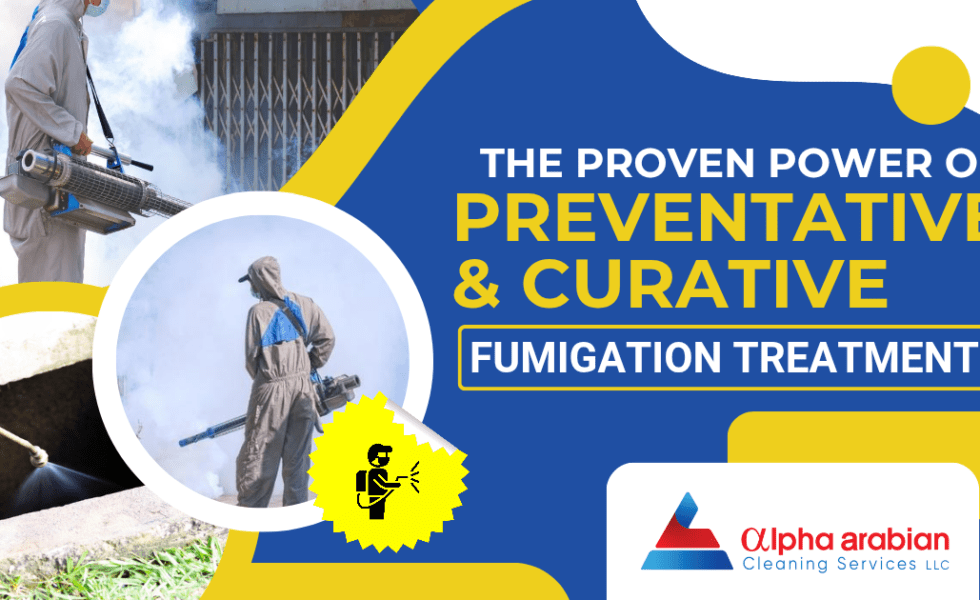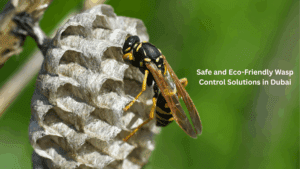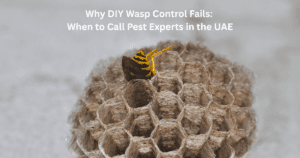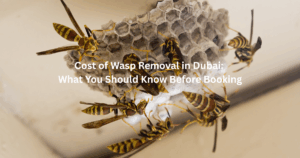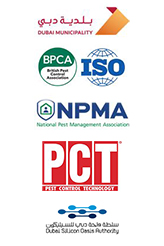Preventative and Curative Pest Fumigation Treatments: Safe and Effective Pest Control
Pest infestations pose a significant threat to businesses, especially in agriculture, warehousing, and food storage. Fumigation is an effective pest control method that utilizes insecticidal gases to eliminate infestations at all life stages, including eggs, larvae, pupae, and adults. In UAE, fumigation is crucial for protecting commodities, ensuring compliance with global trade standards, and maintaining food quality.
This article explores various fumigation treatments, highlighting their advantages and importance in protecting stored products.
What is Fumigation?
Fumigation is a pest control method that uses an insecticidal gas to target a specific area, allowing it to seep into cracks, crevices, and pores to eliminate pests. This technique is commonly employed to treat stored goods, prevent infestations in agricultural products, and protect structures from pest damage.
Key Benefits of Fumigation
- Comprehensive Pest Elimination – Targets all life stages of insects, ensuring total eradication.
- Non-Residual Treatment – Leaves no harmful residues on food products or surfaces.
- Regulatory Compliance – Meets international quarantine and export trade requirements.
- Versatile Application – Effective for silos, warehouses, containers, and large structures.
- Prevention of Microbial Growth – Helps control mould and fungi in stored goods.
Types of Pest Fumigation Treatments
Silo Fumigation
Silo fumigation serves to effectively treat substantial quantities of stored grains and other commodities within silos. This method focuses on eradicating all pests, including concealed larvae and eggs. For the fumigation process to be successful, silos must adhere to specific sealing requirements to prevent gas leakage.
Structure Fumigation
Whole-building fumigation is a powerful solution designed to combat major pest infestations in various structures, including warehouses, mills, and processing plants. The facility is completely sealed and then treated to eliminate pests.
Container Fumigation (Static)
Container fumigation is crucial for international trade, ensuring that shipping containers and their contents remain pest-free. This process prevents invasive pests across borders and helps maintain compliance with import-export regulations.
What is a Fumigant and Fumigation Process?
Fumigants are volatile pesticides that function as poisonous gases within enclosed environments, thereby effectively exterminating pests. Aluminium Phosphide and Magnesium Phosphide are commonly used fumigants, typically available in tablet or granule form. These substances are often employed to treat grains, nuts, tobacco, and other stored commodities.
Fumigation establishes a sealed, airtight environment that effectively eradicates pests and safeguards your valuable possessions. Fumigant gas is then released, facilitating penetration into all infested areas. Once the treatment is over, ventilate the area to remove any leftover gas and test it for safety before re-entry.
The presence of pests in stored products can lead to significant economic losses and health risks. Common issues resulting from pest infestations include:
- Direct damage to grains and food products
- Contamination from insect debris and excrement
- Structural damage to wooden storage units and packaging
- Mold and fungal growth stemming from pest activities
- Alterations in the taste, smell, and appearance of food products.
Negative Effects of Infestation on Stored Products
- Nutritional Loss – Pests consume essential nutrients in stored grains.
- Ingredient Modification – Infested products undergo chemical changes.
- Adverse Health Effects – Contaminated food can cause foodborne illnesses.
- Economic Losses – Increased wastage and decreased market value.
Why Choose Fumigation Over Other Pest Control Methods?
Fumigation provides comprehensive pest control by reaching the most hidden areas where pests may reside, making it more effective than sprays and baits. It is particularly effective against stored product pests for several reasons: it eliminates all developmental stages of insects, penetrates deeply into infested materials, and works exceptionally well in enclosed environments.
Conclusion
Fumigation is vital for pest management, ensuring food safety, regulatory compliance, and economic protection. It effectively controls pests in agriculture, warehouses, and global trade. For expert fumigation services tailored to your business, trust licensed professionals with extensive experience.
Contact Alpha Arabian today for a customized pest control solution that guarantees safety and efficiency!
Understanding Bees: Life Cycle, Species And Powerful Prevention Strategies
Bees serve an essential role within our ecosystem, contributing to pollination and the preservation of biodiversity. However, their establishment of hives in or adjacent to residential areas may present safety concerns. Understanding the life cycle of bees, their species and appropriate strategies for preventing infestations is essential for coexisting harmoniously with these beneficial insects.
This guide aims to equip individuals with the necessary knowledge to make informed decisions while prioritizing safety for humans and bees.
The Life Cycle of Bees
Bees undergo a comprehensive metamorphosis comprising four distinct stages:
- Egg Stage
A queen bee deposits eggs within the cells of honeycombs. These eggs are diminutive, measuring approximately 1 to 1.5 mm in length. Following an incubation period of around three days, the eggs hatch into larvae.
- Larva Stage
The larval stage represents a period of rapid growth during which the young bees are initially nourished with royal jelly, followed by a diet of honey and pollen. Worker bees provide sustenance to the larvae nearly 1,000 times daily, facilitating their swift development.
- Pupa Stage
During the pupa stage, larvae undergo significant morphological changes, developing distinct features such as wings, legs, and compound eyes. The anatomical structure of the organism increasingly mirrors that of an adult bee.
- Adult Stage
Fully developed bees emerge as either workers, drones, or new queens. Worker bees assume various responsibilities within the hive, drones contribute to the reproductive processes, and the queen perpetuates the lifecycle by laying thousands of eggs throughout her lifespan.
Types of Bees
With over 25,000 bee species identified globally, the following are among the most commonly encountered:
- Honey Bees (Apis mellifera)
Honey bees are essential for pollination and the production of honey. While generally non-aggressive, they defend their hive if they perceive a threat. These bees organize themselves into structured colonies of a queen, drones, and worker bees.
- Bumble Bees (Bombus spp.)
Bumble bees are known for their exceptional pollination capabilities, thriving in flower-rich environments. They inhabit small underground colonies. Although they can sting multiple times, they typically do so only in response to provocation.
- Carpenter Bees (Xylocopa spp.)
Carpenter bees are characterized by their large, blue-black bodies and are known to nest in wood. They may cause structural damage to wooden furniture and buildings. While these bees do not produce honey, they contribute significantly to pollination.
- Killer Bees (Africanized Honey Bees)
Killer bees exhibit greater aggression compared to their non-Africanized counterparts. Typically, they nest near water bodies or dense vegetation and attack in large swarms when provoked.
- Wasps and Hornets (Non-True Bees)
Frequently mistaken for bees, wasps and hornets are generally more aggressive. They construct nests resembling paper, which can be found in trees, attics, or wall cavities. Unlike honey bees, these insects possess the ability to sting multiple times.
This overview encapsulates the diversity of bee species and highlights their ecological significance alongside safety considerations regarding human interaction.
Preventing Bee Infestations
While bees play a crucial role in our ecosystem, unwanted infestations near residential properties can present safety hazards. The following strategies are recommended for effective prevention:
- Identify and Seal Entry Points
Bees often access homes through tiny openings in walls, attics, and vents. Regular inspections and sealing of these entry points are recommended to prevent potential nesting.
- Remove Food Sources
Bees are attracted to sweet and floral odours. It is prudent to avoid leaving sugary beverages, fruits, or open food outdoors, particularly during the warmer months.
- Maintain Your Yard
Trim overgrown vegetation to reduce nesting areas and store woodpiles properly to prevent carpenter bee infestations. Add bee-repelling plants like citronella, eucalyptus, and mint to your landscape.
- Utilize Bee Repellents
Natural repellents, including cinnamon, garlic, and vinegar sprays, can effectively deter bees from nesting in undesired locations. However, it is vital to use these substances judiciously to avoid negatively impacting beneficial pollinators.
- Install Protective Screens
Using mesh screens on windows, vents, and chimneys will prevent bees from entering homes while allowing adequate ventilation.
- Relocate Beehives Professionally
If you spot a beehive near your home, admire its beauty and avoid disturbing it. Instead, contact a licensed beekeeper or pest control service for safe relocation.
- Address Existing Infestations Promptly
If bees are found inside walls or ceilings, do not seal the entry point immediately. Trapped bees might look for other escape routes within the structure. It is advisable to engage pest control professionals to facilitate the removal of aggressive species, such as Africanized bees or wasps, in a manner that ensures safety and efficiency.
Conclusion
Bees are a fundamental part of our ecosystem, contributing to pollination and biodiversity. However, infestations near homes and businesses can be hazardous. By understanding their lifecycle, species, and prevention methods, we can make informed decisions that ensure safety while preserving these essential pollinators. If you suspect a bee infestation, always seek expert assistance, like Alpha Arabian Pest Control Service, to manage the situation responsibly.
Discover the Hidden Dangers: How Dust Affects Your Health and Home
Dust accumulation is a common phenomenon observed in every corner of the globe. It settles relentlessly on various surfaces, including the polished wood of furniture, the delicate screens of electronic devices, and the often-neglected nooks of flooring. This fine layer of dust can not only obscure the beauty of these surfaces but also serve as a reminder of the ongoing battle against the elements in our indoor environments.
Engaging in a professional dust removal service in Dubai can mitigate the potential hazards associated with dust accumulation and enhance the quality of the indoor environment. This article examines the hidden risks attributed to dust and discusses how specialized cleaning services can significantly improve indoor air quality and overall hygiene.
The Health Risks of Dust
Dust is a mixture of tiny particles, including fine dirt, airborne pollen, pet dander, and potentially harmful bacteria that can linger in the air. When inhaled over extended periods, dust can lead to various respiratory issues, trigger allergic reactions, and cause skin irritations. It is crucial to effectively manage dust accumulation, as neglecting this issue can aggravate pre-existing health conditions, such as asthma.
This exacerbation can lead to increased difficulty in breathing, ultimately impacting the overall well-being of affected individuals. By enlisting the services of a professional cleaning company in Dubai, you can ensure thorough and effective removal of dust, promoting a healthier indoor environment and significantly improving the quality of the air you breathe.
How Dust Damages Your Home
Dust is more than just an unwelcome guest in our homes; it poses a significant risk to our health and the integrity of living spaces. Dust accumulation on furniture, floors, and electronics diminishes their beauty and can cause irreversible damage. The fine particles can settle into crevices, scratching delicate finishes and dulling vibrant colours. Additionally, dust has a sneaky way of clogging air vents, forcing your cooling systems to work overtime and straining efficiency.
By enlisting a reliable dust removal service in Dubai, you can safeguard your home from these detrimental effects while preserving its aesthetic appeal and ensuring a healthier environment for you and your family.
Keeping Dust Outside
Maintaining a clean indoor environment begins with preventing dust from infiltrating the home. Several effective strategies may be employed to achieve this objective, including the usage of fiber doormats designed to capture dirt from footwear, ensuring that windows remain closed during periods of high foot traffic, and effectively sealing any cracks in doors and windows.
Engaging a professional cleaning service in Dubai can provide valuable guidance in implementing these preventive measures to minimize dust accumulation within the living space.
The Role of Air Filters and Purifiers
One of the most effective strategies for minimizing indoor dust accumulation is the utilization of air filters and purifiers. It is recommended that air filters be replaced every three months to mitigate the circulation of dust particles. Air purifiers serve to capture airborne dust before it settles on surfaces. When these devices are used alongside a trusted dust removal service in Dubai, they significantly improve indoor air quality.
Cleaning and Maintenance Tips
Regular cleaning is crucial for managing dust and allergens in your home. Wash your bedding every two weeks to reduce dust mites, and groom your pets frequently to minimize hair and dander. Using a vacuum with a HEPA filter can capture 99.7% of dust particles.
For a thorough cleaning, consider hiring a professional cleaning service in Dubai. They use advanced techniques for effective dust removal, improving your home’s cleanliness and air quality. Implementing these tips can help create a dust-free environment.
Benefits of Professional Dust Removal
Hiring a dust removal service in Dubai offers numerous advantages. These professionals utilize advanced equipment for deep cleaning, significantly reducing airborne allergens and pollutants in your home. Additionally, regular dust removal can help extend the lifespan of your furniture and appliances, saving you money in the long run.
Choosing professional cleaning services allows you to maintain a healthier living space, keeping your home free from dust and allergens. This proactive approach not only enhances the quality of indoor air but also promotes overall well-being. Embracing professional dust removal is a smart choice for maintaining a clean and comfortable home.
Conclusion
Dust affects both health and home environments. While regular cleaning is essential, Alpha Arabian Cleaning Service offers the most effective solution. Whether you need dust removal or a comprehensive cleaning service in Dubai, investing in professionals ensures your home remains clean and safe.
With Alpha Arabian Cleaning Service, you can maintain a healthier living space by minimizing allergens and dust-related issues. Their expertise guarantees thorough cleaning, contributing to your overall well-being. Choose Alpha Arabian for a dust-free home and enjoy peace of mind knowing your space is in good hands.
